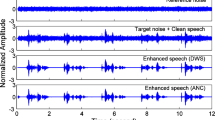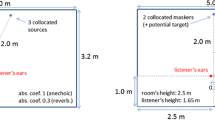Abstract
Lombard speech is an involuntary adaptive change in voicing under the influence of noise. In the current study we examine the relationship between involuntary auditory-speech control, common for Lombard speech, and voluntary control of phonation, which occurs as a result of the visual estimation of the distance to the listener (1 and 4 m). Fundamental frequencies (F0) were estimated in nine normally hearing Russian female speakers aged 20–35 years. An increase in F0 was obtained when the communicative conditions became more complex in both cases of an increase in surrounding background noise level and growth of talker-to-listener distance. In quiet and in noise of 60 and 72 dB the increase in talker-to-listener distance led to F0 increments of 14, 18, and 15 Hz, which did not differ significantly from each other (p > 0.05, n = 288). When the communicative distance was held constant, babble noise of different levels led to significantly different values of ΔF0: for 1 m distance–14 and 32 Hz (p < 0.001, n = 288), and for 4 m–18 and 33 Hz (p < 0.001, n = 288), respectively. The data obtained is evidence of the independent and additive impact of noise and communicative distance on phonation.




Similar content being viewed by others
REFERENCES
Hage, S.R. and Nieder, A., Dual neural network model for the evolution of speech and language, Trends Neurosci., 2016, vol. 39, no. 12, p. 813.
Brumm, H. and Zollinger, S.A., The evolution of the Lombard effect: 100 years of psychoacoustic research, Behaviour, 2011, vol. 148, nos. 11−13, p. 1173.
Luo, J., Hage, S.R., and Moss, C.F., The Lombard effect: from acoustics to neural mechanisms, Trends Neurosci., 2018, vol. 41, no. 12, p. 938.
Liénard, J.S. and Di Benedetto, M.G., Effect of vocal effort on spectral properties of vowels, J. Acoust. Soc. Am., 1999, vol. 106, no. 1, p. 411.
Traunmüller, H. and Eriksson, A., Acoustic effects of variation in vocal effort by men, women, and children, J. Acoust. Soc. Am., 2000, vol. 107, no. 6, p. 3438.
Koenig, L.L. and Fuchs, S., Vowel formants in normal and loud speech, J. Speech Lang. Hear. Res., 2019, vol. 62, no. 5, p. 1278.
Nonaka, S., Takahashi, R., Enomoto, K., et al., Lombard reflex during PAG-induced vocalization in decerebrate cats, Neurosci. Res., 1997, vol. 29, no. 4, p. 283.
Hage, S.R., Jürgens, U., and Ehret, G., Audio–vocal interaction in the pontine brainstem during self-initiated vocalization in the squirrel monkey, Eur. J. Neu-rosci., 2006, vol. 23, no. 12, p. 3297.
Garnier, M., Henrich, N., and Dubois, D., Influence of sound immersion and communicative interaction on the Lombard effect, J. Speech Lang. Hear. Res., 2010, vol. 53, no. 3, p. 588.
Pick, Jr.H.L., Siegel, G.M., Fox, P.W., et al., Inhibiting the Lombard effect, J. Acoust. Soc. Am., 1989, vol. 85, no. 2, p. 894.
Therrien, A.S., Lyons, J., and Balasubramaniam, R., Sensory attenuation of self-produced feedback: the Lombard effect revisited, PLoS One, 2012, vol. 7, no. 11, e49370
Tonkinson, S., The Lombard effect in choral singing, J. Voice, 1994, vol. 8, no. 1, p. 24.
Bottalico, P., Graetzer, S., and Hunter, E.J., Effect of training and level of external auditory feedback on the singing voice: volume and quality, J. Voice, 2016, vol. 30, no. 4, p. 434.
Weisser, A., Miles, K., Richardson, M.J., and Buchholz, J.M., Conversational distance adaptation in noise and its effect on signal-to-noise ratio in realistic listening environments, J. Acoust. Soc. Am., 2021, vol. 149, no. 4, p. 2896.
Fux, T., Feng, G., and Zimpfer, V., Talker-to-listener distance effects on the variations of the intensity and the fundamental frequency of speech, in 2011 IEEE International Conference on Acoustics, Speech and Signal Processing, May 22–27, 2011, p. 4964.
Hage, S.R. and Jürgens, U., On the role of the pontine brainstem in vocal pattern generation: a telemetric single-unit recording study in the squirrel monkey, J. Neurosci., 2006, vol. 26, no. 26, p. 7105.
Pieper, F. and Jürgens, U., Neuronal activity in the inferior colliculus and bordering structures during vocalization in the squirrel monkey, Brain Res., 2003, vol. 979, nos. 1−2, p. 153.
Pelegrín-García, D., Smits, B., Brunskog, J., and Jeong, C.H., Vocal effort with changing talker-to-listener distance in different acoustic environments, J. Acoust. Soc. Am., 2011, vol. 129, no. 4, p. 1981.
Keith, R.W., Development and standardization of SCAN-C test for auditory processing disorders in children, J. Acoust. Soc. Am., 2000, vol. 11, no. 8, p. 438.
Andreeva, I.G., Dymnikowa, M., Gvozdeva, A.P., et al., Spatial separation benefit for speech detection in multi-talker babble-noise with different egocentric distances, Acta Acust. United Acust., 2019, vol. 105, no. 3, p. 484.
Marks, L.E., Binaural summation of loudness: noise and two-tone complexes, Percept. Psychophys., 1980, vol. 27, no. 6, p. 489.
Coleman, P.D., An analysis of cues to auditory depth perception in free space, Psychol. Bull., 1963, vol. 60, no. 3, p. 302.
Shih, C. and Lu, H.Y.D., Effects of talker-to-listener distance on tone, J. Phonetics, 2015, vol. 51, p. 6.
Cheyne, H.A., Kalgaonkar, K., Clements, M., and Zurek, P., Talker-to-listener distance effects on speech production and perception, J. Acoust. Soc. Am., 2009, vol. 126, no. 4, p. 2052.
Meekings, S., Evans, S., Lavan, N., et al., Distinct neural systems recruited when speech production is modulated by different masking sounds, J. Acoust. Soc. Am., 2016, vol. 140, no. 1, p. 8.
Meekings, S. and Scott, S.K., Error in the superior temporal gyrus? A systematic review and activation likelihood estimation meta-analysis of speech production studies, J. Cognit. Neurosci., 2021, vol. 33, no. 3, p. 422.
Funding
This study was supported by the Russian Science Foundation (project no. 22-25-00068).
Author information
Authors and Affiliations
Corresponding author
Ethics declarations
COMPLIANCE WITH ETHICAL STANDARDS
All studies were carried out in accordance with the principles of biomedical ethics, formulated in the Declaration of Helsinki 1964 and its subsequent updates, And approved by the local ethics committee of the Institute of Evolutionary Physiology and Biochemistry (St. Petersburg).
Informed consent. Each participant in the study provided a voluntary written informed consent signed by him after explaining to him the potential risks and benefits, as well as the nature of the upcoming study.
Conflict of interest. The authors declare the absence of obvious and potential conflicts of interest related to the publication of this article.
AUTHOR CONTRIBUTION
A.M. Lunichkin, I.G. Andreeva, and A.P. Gvozdeva—the idea of work and the planning of the experiment, A.P. Gvozdeva—preparation of the methodology, A.M. Lunichkin—data collection and processing, A.M. Lunichkin, I.G. Andreeva, and A.P. Gvozdev—writing and editing the manuscript.
Rights and permissions
About this article
Cite this article
Lunichkin, A.M., Gvozdeva, A.P. & Andreeva, I.G. The Impact of Visual Estimates of Talker-to-Listener Distance on Fundamental Frequency in Noise. Hum Physiol 49, 281–288 (2023). https://doi.org/10.1134/S0362119723700226
Received:
Revised:
Accepted:
Published:
Issue Date:
DOI: https://doi.org/10.1134/S0362119723700226




